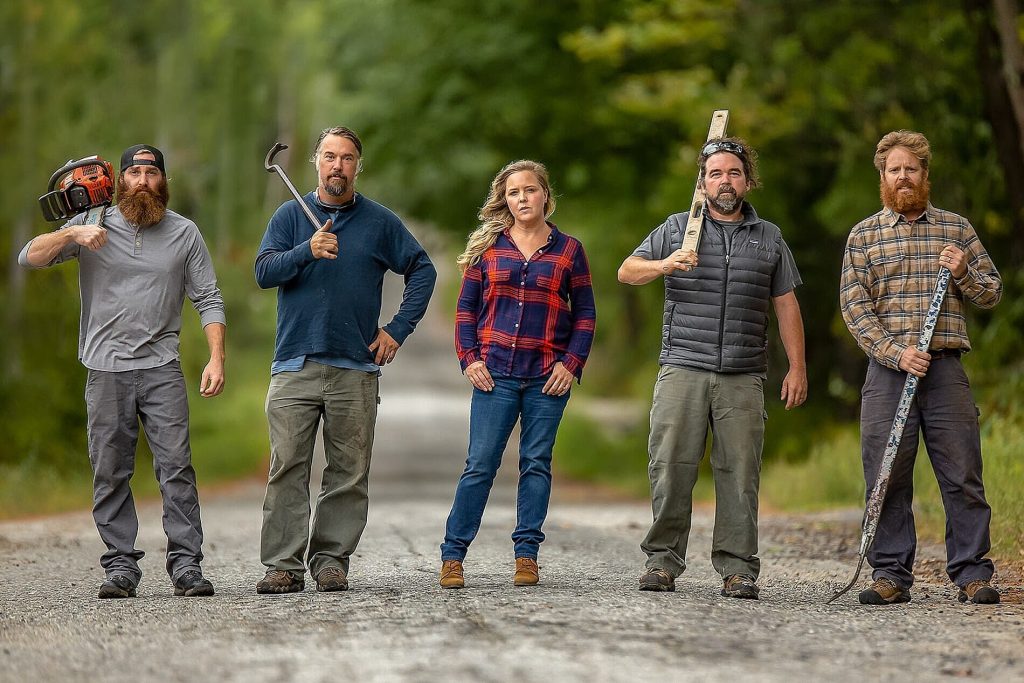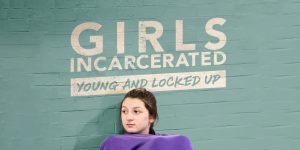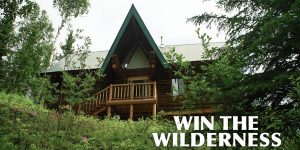Many people are – or perhaps were – charmed by the idea of owning a cabin, and this made the reality-television series, “Maine Cabin Masters,” a favorite among cable viewers. However, the difficulty of maintaining a cabin in good condition has become a nightmare for some owners. The experts that comprised the cast of the TV show had been transforming neglected cabins around Maine, including those located in some of the most secluded spots. It became the highest-rated show on the DIY network in its first three seasons, so suffice to say that the main cast also gained prominence, and people wondered how much they earned through the years.
“Maine Cabin Masters” – How it all started?
With all the renovation-themed TV shows that reign supreme in the world of reality television, it was the first time that a show focused on rebuilding cabins in a specific area. It all started back in 2015, when a reputable contractor named Chase Morrill was introduced by a family friend to one of the TV producers of Dorsey Productions from Denver, Colorado.
https://www.instagram.com/p/CPld2kILn8z/
The company was already putting up a reality-TV show, and was looking for a carpentry crew based in Maine who had years of experience in restoring old log cabins, camps, and cottages.
Initially, Chase thought that his friend was pulling his leg, but he still conferred with his team, which was at that time in the middle of working on their Timber Barn Project. They all reacted just like Chase, feeling it was a prank. The TV producers were interviewing other people too, but out of curiosity, Chase emailed the production company and asked if the proposition was real. Chase and his crew were interviewed via Skype, and fitted the profile that the producers were looking for; basically, it was the fact that his crew was comprised of family and friends, along with the beard that the men had been sporting that day. It also helped that they had a great sense of humor, and really had great chemistry. Result – the executives at Dorsey Productions gave the green light to start filming the pilot episode that year.
https://www.facebook.com/mainecabinmasters/photos/4496897750340903
Just like any other home make-over show, the camera crew followed Chase and his team from his company Kennebec Property Services LLC, as they worked on renovating old cabins and camps all over Maine. They filmed the pilot episode near a pondside camp in Vassalboro, and when it was pitched to the DIY network, it was immediately picked up and 10 episodes were ordered to complete one season. “Maine Cabin Masters” premiered on 23 February 2016, and has now been doing make-overs one at a time for the past five years.
Meet the “Maine Cabin Masters” Experts
The main cast of “Maine Cabin Masters” was comprised of cabin rebuilding experts such as Chase Morrill, along with his sister Ashley Morrill-Eldridge and her husband Ryan Eldridge. While they are the main stars of the show, the three of them wouldn’t have been able to complete all the projects in time without help of their friends, including Matt Dix and Jared Baker.
Chase Morrill (Carpenter/Contractor)
After the first season of the TV show aired, Chase Morrill became popular not only in the local communities in Maine, but around the whole country and beyond. “Maine Cabin Masters” has found its place on cable television, and has since been available worldwide through online streaming. Some of the fans refer to Chase as the master of the cabins.
Chase was born on 25 December 1977, in Augusta, Maine, USA. He came from a large family, and was referred to by many as a 10th generation Mainer, whose ancestors probably had something to do with building the framework for the separation of Maine from Michigan. His parents, Eric and Peggy Morrill, raised their children in a middle-class lifestyle. Chase graduated with a bachelor’s degree from the Liberal Arts College, University of Atlantic located in Bar Harbor, Maine.
His passion for building was inspired by his grandfather – a civil engineer who loved building his own home – and by his father, a builder by profession who taught him all the basics of cabin building. He grew up surrounded by people who loved to build their own homes, camps, cabins, and cottages.
Ashley Morrill – Eldridge (Designer)
Ashley Morrill-Eldridge was born on 27 January 1976. Since her family was big on building homes and cabins, she also learned everything about it from their father. She graduated with a bachelor’s degree in Graphics Design from the University of Southern Maine. Ashley is the project designer, and the only female in Chase’s crew, so she took care of everyone most especially with the items that most men would never think about. She noticeably balances things out during stressful moments, when they’re trying to meet deadlines so finishing-up a season without disappointing the cabin owners.

Ryan Eldridge (Carpenter)
Ryan is the husband of Ashley. They’ve known each other since they were in their teens, and married after two years of dating; he proposed to her during a Willie Nelson concert, which Ashley said was quite unforgettable. The couple don’t have any children, but are fur parents to two dogs named Sadie and Gus. Ryan works as a carpenter in the company, and claims that his presence in the TV show is what balances the brother-sister relationship, also saying that he’s the voice of reason during discussions about the projects that they accept.
Matt “Dixie” Dix (Carpenter)
One of the reliable carpenters in Chase’s cabin building team is Matt Dix, fondly called Dixie by his friends and colleagues. He was born on 13 April 1973, in Augusta, Maine, to parents who have been married for 50 years, and who raised him in a comfortable household.
There isn’t much information about his father, because he was a very private man, but his mother was the former Human Resources Vice President of Maine Bank & Trust, and also worked at the People’s United Financial as its Human Resources Manager, retiring in 2013.
Just like most boys in Maine, Dixie grew up going to camps during holidays, and learned how to build homes by acquiring carpentry skills. In one episode in the third season of “Maine Cabin Masters,” they restored his grandmother’s cabin by spending $25,000 on it.
Jared Baker (Carpenter)
Not much personal information can be found about Jared Baker, who also goes by the name Jedi, except that he was born on 20 December 1978. He works as a carpenter in Chase’s company, and when Chase was offered a chance to be on a reality-TV show, he was included in the crew.
In the many years that he did carpentry work, he would always practice safety above anything else, so it was ironic that he was injured by falling from the roof while trying to break into his own house at two in the morning because he lost his keys and the rain was pouring down.
Sixth member but he left the show
There was a sixth member of the crew named Lance Gatcomb, but he left by the fourth season. No one talks about him anymore, and there was no explanation as to why he never appeared in the show again. Lance was often described as the quirky guy on the team, and provided the entertainment part of the show by getting donuts using the motorboat, while everyone’s busy working to meet the deadline, or sleeping in a hammock with a bag of Cheetos. In any TV series, when a member of the cast left the show and it’s shrouded in mystery, fans would immediately conclude that he had a huge falling out with one of the stars of the show, or the production crew.
Unfortunately for the loyal fans, stalking social media couldn’t help, as Lance doesn’t have a Twitter or Instagram account. His last Facebook post was back in 2013 – he hasn’t updated its status since then.
How authentic is the “Maine Cabin Masters?”
Two of the major questions that fans want to ask reality-TV stars is how authentic was their TV show, and were they following a certain script to fit the narrative that the producers wanted to achieve? Chase said in an interview with Press Herald that in their case, they practically just say whatever they wanted to say, and the editors just clean it up. Sometimes, stress could make their conversations a little more colorful, especially the night before they’re supposed to reveal the finished product to cabin owners.
During the first season, the producers had a list of demands on what should happen or what needs to be done. After a while, Chase said that their ultimate responsibility was to the cabin owner, as they were the ones shelling out the money, so their expectations must be the top priority over the production crew’s expectations.
Chase and his team were quite realistic in the sense that they were aware that long after the TV show was gone, they would still be living and working in Maine. He admitted that sometimes it was hard to balance things, but they made it work as they told the producers that their names were on the line each time they worked on the cabins, and it’s their reputation that would suffer if they failed to meet the expectations of the owners. They also realized that the TV show should also be entertaining and not just informative, so once in a while, they did crazy things they wouldn’t normally do, to make it fun.
If there was one thing Chase said that his team was grateful for was that the crew from Dorsey Productions was one decent group of people. They all knew that with all the footage filmed in the first season, the producers could have presented them in whatever way they wanted. It could have been edited to make them look bad, but everything turned out great for them.

He said that it was probably because they saw how they had fun working together on the cabins, and that Maine had that perfect scenic background so the producers could include that too. It was a good decision since most of the feedback they had was positive, with fans saying that they would love to visit Maine.
Six seasons of “Maine Cabin Masters”
After they finished filming the first season, Chase and his crew never thought that they would have another, because it was quite difficult as they didn’t have any idea about television production; it served as a very steep learning curve for all of them. They were often stressed out, and he felt that they found themselves way over their heads when they accepted the reality-TV series. He naively thought that “Maine Cabin Masters” would be easy to do, as the TV crew would just follow them around on their daily work. When they finished filming, all of them were kind of relieved.
However, by the third season, they were all able to adjust to the grueling pace.
https://www.instagram.com/p/COK5l2iLXxf/
While Chase said that he would still shout at his sister now and then, they enjoyed filming now. It can still be stressful, but they knew how to take it all in their stride.
Another question that fans usually asked them was what their priority was when they take on a project – to restore or to upgrade? Chase said that the priority was always to restore, if possible, and not ruin its original design. The producers would often demand the “wow” factor, but Chase needed to preserve the rustic charm of the cabins. However, sometimes it boiled down to what the cabin owner wanted, but generally they found a way to restore some parts, while upgrading the rest for practical reasons.
“Maine Cabin Masters” has consistently been one of the top most-viewed reality-TV shows on the DIY network over the six seasons. Each season had something new to offer, and viewers loved it when the crew went to some of the most remote places in Maine that they needed to fly a small plane just to reach site, sometimes an island to fix some camps.
When the pandemic happened due to the Covid-19 virus in 2020, filming became a challenge. There were many restrictions and regulations to follow associated with travel, quarantine, social distancing, and vaccination. They all needed to make sacrifices when they filmed the fifth season – a small group could easily be managed, but when there’s a large group of people involved, safety should always be the priority. During the sixth season, the producers needed to become creative, because they could no longer film to avoid more people being exposed to the virus. The problem was that they didn’t have enough content to complete one whole season. They opted to just air favorite moments, or the best 10 cabins or camps. They even featured a Question and Answer episode so that they could still give new episodes to the fans, while avoiding putting many people at risk by filming the usual episode content.
https://www.facebook.com/mainecabinmasters/photos/4253241658039848
Are the renovation budgets in “Maine Cabin Masters” for real?
If there was one thing quite different with “Maine Cabin Masters” from other renovation-themed TV shows, it was the budget that they worked with. People couldn’t believe that Chase’s crew could work on rebuilding a cabin with a mere $30,000, when other renovation shows had astronomically large budgets, because an upgraded kitchen alone could cost six figures.
Both cast and crew of the TV show said that the budgets were real, and also footed by the cabin owners, but some TV insiders said that they probably received some stipend from the producers, most especially if they wanted that “wow” factor. The services of the main cast were usually covered by their on-air appearance fee, so basically the labor cost of each project was paid by the DIY network. Chase also said in an interview that they liked to preserve, and not throw out any material that could still be used in renovating the place.
https://www.instagram.com/p/CNqLVGhsxNS/
How much does the “Maine Cabin Masters” earn?
Since the cast of the “Maine Cabin Masters” created beautiful cabin and camp renovations, the fans were mostly curious about how much they earned, most especially since the show was one of the most popular in cable television entertainment.
Chase’s company, now called Kennebec Cabin Company, would normally be paid $30,000 to $35,000 per project. Due to Covid-19, their business picked up, as there was a surge of people who wanted to get away from all that was happening in their residences in the metropolitan areas. To avoid the pandemic, most people wanted to go back to their rural roots, so many owners contacted Chase’s company to handle their neglected cabins and camps. In short, they had plenty of work during the off-season.
According to authoritative sources, Chase has an estimated net worth of $600,000, while his sister Ashley ($460,000) and brother-in-law Ryan Eldridge ($400,000) have a total net worth of close to $900,000.










Leave a Comment